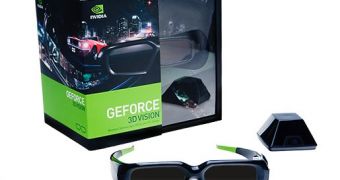Advanced Micro Devices and NVIDIA may have finally begun to fight it out on the DirectX 11 front, but they are also in a race to see which manages to bring out a popular gaming-enhancing technology. At present, they can both be said to have come up with something. ATI has the Eyefinity multi-display technology, whereas NVIDIA is heavily advertising its 3D Vision and 3D Vision Surround gaming ideas. Game developers, however, don't seem to see these solutions as overly popular.
According to a report published by Joystiq, THQ, one of the largest publishers of games worldwide, doesn't think that Stereoscopic 3D Gaming will catch on, at least not for a couple of years. The reason is, predictably, related to finances or, to be more exact, the amount of cash that consumers have on hand to spend on display solutions. To this are added the funds needed to put together an NVIDIA 3D Vision kit, which converts 'regular' games into 3D.
Stereoscopic 3D Gaming relies on a 3D monitor or HD TV, neither of which is commonly found in most gamers' homes. Obviously, this is because 3D displays, regardless of maximum resolutions, are relatively few in number and, of course, quite expensive compared with regular video-output devices. This is why THQ doesn't have any plans to invest very much into video games optimized for stereoscopic 3D, at least not in the near future.
“There are some neat things we see. We need two things: we do need some additional console technology and I do not want to get into particulars on that, but more importantly and probably a little further out, is the install base of 3D-equipped TV sets or monitors. [I do not believe that stereo 3D] will be meaningful for a couple [of] years. [We will] watch the ramp of 3D monitors,” Brian Farrell, chief executive of THQ, said during the quarterly conference call with financial analysts, Joystiq reports.

 14 DAY TRIAL //
14 DAY TRIAL //